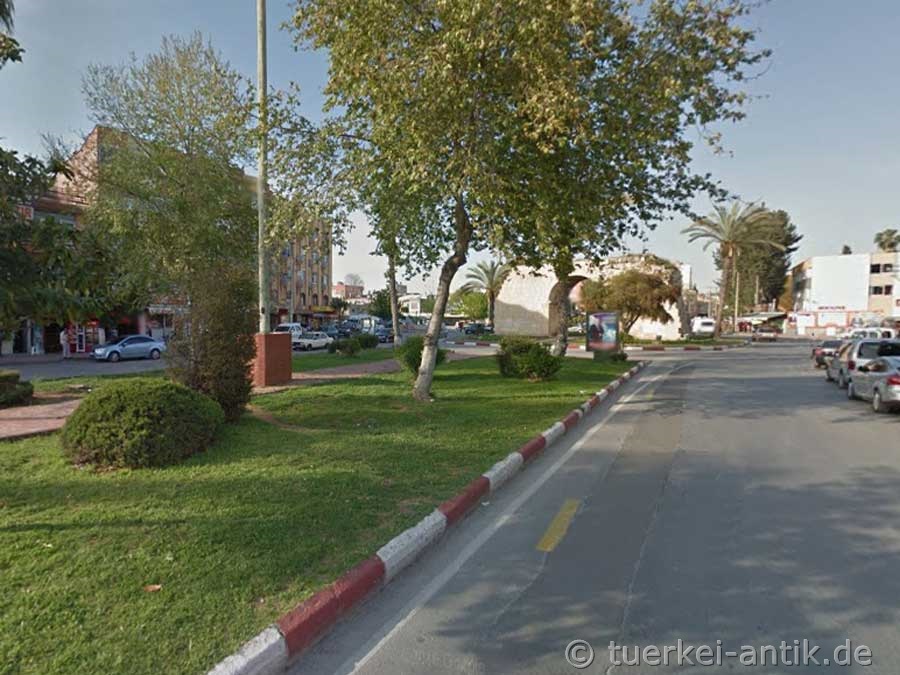 |
| Tarsus in Cilicia | |||
 |
|
||
| İsmet Paşa Blv. | |||
|
The city of Tarsus has been known since ancient times as the birthplace of the apostle Paul. The former port city was about two to three kilometres away from the Mediterranean Sea and was accessible via the navigable river Kydnos (today Berdan Çayı). Today the harbour is silted up and the town is about 16 km from the sea. The city has had trade relations with Phoenicia and Egypt since ancient times. |
|||
|
|
|||
| The Cleopatra Gate on Mersin Cad. | |||
|
In 41 B.C., the famous meeting of Cleopatra with Marcus Antonius took place in Tarsus. On a green traffic island in the main street (Mersin Caddesi) stands the Roman "Cleopatra Gate" (Cleopatra Kapısı). It should remind of the meeting of Cleopatra and Marcus Antonius, but was built about five centuries later. |
|||
|
|
|||
| The Roman Road on Republic Square | |||
|
At the beginning of the 1990s, an approximately 2,000 year old Roman road was found on the Platz der Republik during excavations at a depth of approx. 3 metres. |
|||
|
|
|||
| Foundations of Roman residential and commercial buildings | |||
|
Along the road, foundations of residential and commercial buildings could be uncovered. It is safe to assume that there are still many remains of ancient buildings underneath the city centre. This is indicated not least by the water pipes found and a wastewater tunnel that is still intact in parts. |
|||
|
|
|||
|
|
|||
| The Roman temple Donuktaş | |||
|
|
|||
|
In the Tekke district there are the remains of an imposing building, the foundation of a huge Roman temple. The remains are 115 metres long and 45 metres wide. The walls are up to 6.60 metres thick and consist of Roman concrete. Findings in the vicinity of the temple prove that the outer surfaces were covered with large marble slabs. This fact comes very close to the version that it is a Roman temple of Jupiter or Zeus. However, a temple for the cult of the emperor is also an option. The structure visible today only shows the filling material stabilised with large blocks of stone between the cladding panels. |
|||
|
|
|||
|
|
|||
|
View through the only access to the interior |
|||
|
The name Donuktaş, "frozen stone" or donükta, "turned stone" originated from a tradition according to which Donuktaş was a castle in which a ruler lived with his daughter. One day the ruler got into a fight with a prophet. This kicked ragingly against the massive walls of the building, which then fell down the hill and remained upside down. |
|||
|
Robert Koldewey, a German architect and building researcher had documented quite conclusively in 1890 after investigations at the ruin that it is a (probably) Roman temple building with 10 columns on the narrow sides, which the latest excavations basically confirm. Prof. Dr. Nezahat Baydur of the Museum Tarsus, who led excavations in the temple in the years 1985-1992, dates the beginning of construction of the temple to the time of the Antonine dynasty of Roman emperors, i.e. to the time of the emperors Nerva until Commodus. ( 96 - 192 A.D.) |
|||
|
|
|||
| The Justinian Bridge | |||
|
The bridge was named after the Byzantine emperor Justinian, who had it built during his reign (527 - 565 AD). Tarsus, once a port city only 3 km from the sea, could be reached from the sea via the river Kydnos (today Berdan Çayi). The land route from Soli or Pompeiopolis (Mersin) to Adana crossed this river. The increasing silting up of the estuary by the sediments transported by the Kydnos constantly changed the course of the river and there were repeated floods which severely impaired a river crossing. Emperor Justinian initiated and subsidized the construction of a relief canal that facilitated the outflow of the Kydno and still forms parts of the river bed today. For an unhindered crossing of this canal an approx. 60 meter long stone bridge was built, which is named after its builder today. The bridge, now out of service, was restored in 1978 and integrated into the newly built Kuva-i Milliye Parkı |
|||
| Photos: @chim | |||
| Translation aid: www.DeepL.com/Translator | |||
| Source: Wikipedia and others | |||
|
|
|||

